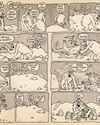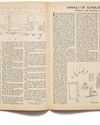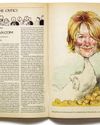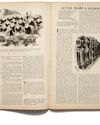CATEGORIES
Kategorier
Kultur

SUBJECT AND OBJECT
What happened when Lillian Ross profiled Ernest Hemingway.

ROYAL FLUSH
The fall of red.

Roz Chast on George Booth's Cartoons
There's almost nothing I like more than a laughing fit. It is a non-brain response, like an orgasm or a sneeze.

CHUKA
I have always longed to be known, truly known, by another human being. Sometimes we live for years with yearnings that we cannot name.

Rachel Aviv on Janet Malcolm's "Trouble in the Archives"
As Janet Malcolm worked on \"Trouble in the Archives,\" a two-part piece about prominent psychoanalysts who disagreed about Freud, she began a correspondence with Kurt Eissler, the head of the Sigmund Freud Archives.

PERSONAL HISTORY - A VISIT TO MADAM BEDI
I was estranged from my own mother, so a friend tried to lend me his.

AMERICAN CHRONICLES - WAR OF WORDS
Editors, writers, and the making of a magazine.

LIVE FROM NEW YORK
A new docuseries commemorates fifty years of \"Saturday Night Live.\"

TANGLED WEB
An arachnophobe pays homage to the spider.

TROUBLE IN PARADISE
Mike White's mischievous morality plays.

SISTERHOOD
A remarkable alliance between an order of Catholic nuns and the women on Texas's death row.

Jia Tolentino on Joan Didion's "everywoman.com"
Joan Didion: one thinks of the Stingray, the mohair throw and the typewriter, bloodshed in Laurel Canyon, the decaying Summer of Love.

STEPPING OUT
High-school band contests turn marching into a sport—and an art.

A TROUBLESHOOTING GUIDE TO YOUR MOVING WALL OF SPIKES
Problem: Moving wall of spikes starts inching across room toward victim, stops midway; straining sounds.

Kevin Young on James Baldwin's "Letter from a Region in My Mind"
The reputation of the writer James Baldwin rose and fell during his lifetime, but since his death, in 1987, his star has only ascended.

THE CONTROL OF NATURE - HELICOPTER PARENTS
The daring attempts to teach an endangered ibis species to migrate.

SOME FRESH HELL
The poet Shane McCrae journeys through the land of the damned.

THE CRITICS IN HIS CUPS
The intoxicating still-lifes of Giorgio Morandi.

HALF THE BATTLE
Why can't the U.S. military fill its depleted ranks?

LEANING TOWER
How a high-rise condo in Manhattan went sideways.

MY FRIEND PINOCCHIO DAVID RABE
When I broke Kenny's bedroom door, I was in the middle of a crazy argument with my girlfriend.

PLAY IT AGAIN
\"Hugh Jackman LIVE\" and \"Beckett Briefs.\"

UNTESTED
The frustrated promise of the rape kit.

DEVELOPMENTAL MILESTONES OF YOUR ELON MUSK
The way your Elon Musk plays, moves, and communicates offers important data about his development. Although every child is different, recognizing where your Elon Musk is on the curve can help you identify potential problems early and allow for intervention, under the guidance of your pediatrician and the federal regulatory agency.

TRUE BLOOD
One of the most valuable substances in the world has never been replicated. Are we close?

FEMME VITALE
Alma Mahler-Werfel, a woman with qualities.

SOME PERSONAL NEWS
The rise and rise of the entrepreneurial work ethic.

ARMCHAIR QUARTERBACK
Tom Brady's second act, as a football commentator.

A VISIT FROM THE CHIEF
Lidia often went to the third floor of the Graziano Institute and sat down on the wooden bench there, right across from her mother's room.

LANGUAGE LESSONS
Sanaz Toossi's “English” arrives on Broadway.
